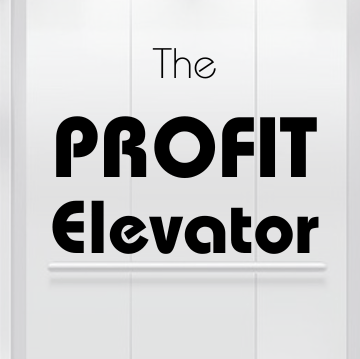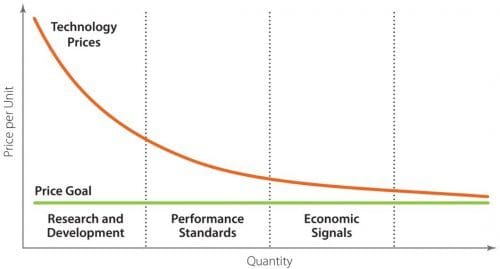
The Big Questions
“My two questions are, how do I know if it’s time to go from non-scalable to scalable work, and how much to spend in 2024.”
This was a client conversation late last year. The events business was attracting customers by word of mouth. Early success suggested that the product met a market need and a decision must be made between bootstrapping or attracting outside investors.
The founder preferred bootstrapping but required advice on scaling that might otherwise come from investors. This is a common scenario.
The Learning Curve
The learning curve is the rate of improvement for each doubling of production. In manufacturing and technology it is assumed to be smooth. Prices fall as the costs to deliver come down.

Source: Energy Innovation Policy & Technology
This works when the steps in a process don’t change, but may be improved through practice. Imagine building houses. If they are all the same then you get better the more you build, as you gain experience of potential problems. But if each house is different, you will take a lot longer to build them.
High volume products sit on the flat part of the curve. Ship a million a year and whether you make another 500 or 5,000 is irrelevant. But if you only make 50, another 500 is huge.
The extreme example is the airline industry. Only around 1,000 large jets are sold each year and it is very expensive to develop a new one. If you overestimate demand, then you never get the efficiencies and the project is scrapped.
Only 251 Airbus A380s were sold. The rise of budget airlines flying directly between smaller airports, damaged the hub and spoke traffic model on which the plane depended. The giant A380 became a dinosaur and ceased production in 2021.
In tech we have the benefit of flexibility. I worked with founders who set out to serve the financial research community. The business struggled to scale and the team pivoted to support the compliance function. They mirrored the switch in spending patterns after the 2008 financial crisis. In time, the business was sold for nine figures to a global data provider.
Ready to Scale
If you have only sold a few copies of your product you are not ready to scale. You cannot assume you have repeat demand, or found the best way to distribute and service. The risks are greatest when you sell to friends and family who are not a true market.
When you see the same things working, whether it’s marketing, selling or servicing, you are ready to scale. You have mapped your sales and production processes and understand which parts don’t change. Automate these first.
In sales, you are ready to scale once your Magic Number hits 0.75. Keep refining the sales process if you are below this.
In customer service, a software development client had problems fulfilling a contract even though the team worked hard. The more they did, the less happy the customer seemed.
The issue was communication. Once my client mapped the delivery process and shared it, their customer noted they changed their mind too often. Lots of things were started but not finished.
The upshot is the team designing a reporting process that is ready to scale. This enables them to select a software that accommodates their process, rather than buying, trying and abandoning an off-the-shelf product. Automating reporting will improve management information and save overhead.
How to Exercises
Study your recent sales. What do they have in common and what is different? If you have 50 sales with unchanged elements, then automate those parts. The precise number varies, depending on whether you make aircraft or compliance reporting tools.
Now compare the last four quarterly costs of customer acquisition with the following quarter’s revenue. If you recover less than ¾ of spending, you are not ready to scale.
Then review your customer service process. What are the common areas for feedback? Has anybody resolved these issues in a way that will work for more clients?
Finally review your run rate of sales. Are you tracking to reach 50, 500 or more units? If not and you are over budget, let’s talk about a possible pivot to a new customer base.
I'm Simon Maughan and I write The Profit Elevator as a guide for smaller businesses to accelerate growth. Ready-to-scale is part of the Opportunity module in my P.R.O.F.I.T. Through Process programme.
If you found this edition valuable, please share it with a colleague and a friend. If you want to know if P.R.O.F.I.T. Through Process is right for you, check out my website.
